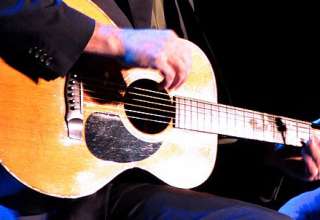Asian Americans Grieve, Organize in Wake of Atlanta Attacks
Asian Americans were already worn down by a year of pandemic-fueled racist attacks when a white gunman was charged with killing eight people, most of them Asian women, at three Atlanta-area massage parlors.
“It didn’t help with former president Trump referring to the COVID-19 pandemic as the Kung Fu virus. Recently there were seven propaganda incidents with direct anti-China references to COVID-19.” – Ed Boitano
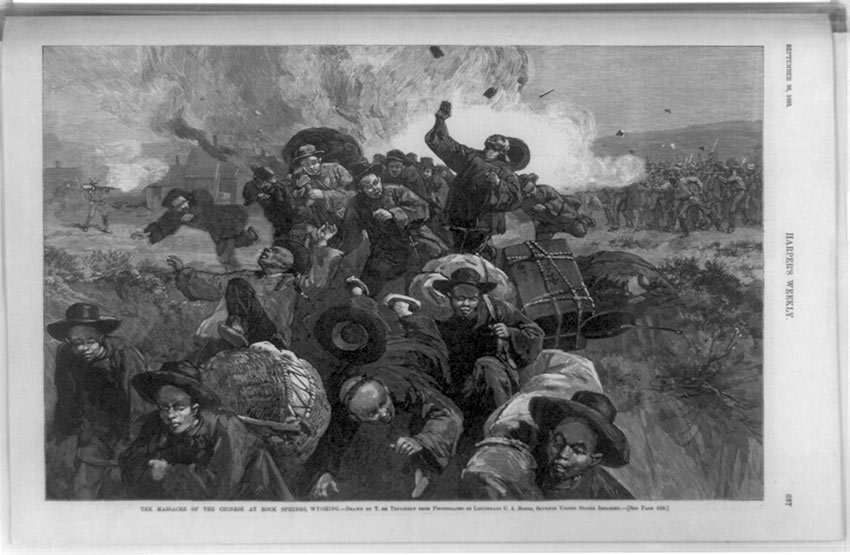
Hundreds of Asian Americans and Pacific Islanders turned to social media to air their anger, sadness, fear and hopelessness. The hashtag #StopAsianHate was a top trending topic on Twitter hours after the shootings that happened Tuesday evening.
“I think the reason why people are feeling so hopeless is because Asian Americans have been ringing the bell on this issue for so long. We’ve been raising the red flag,” said Aisha Yaqoob Mahmood, executive director of the Atlanta-based Asian American Advocacy Fund, which does political and advocacy work across Georgia.
Many were also outraged that the suspect, 21-year-old Robert Aaron Long, was not immediately charged with hate crimes. Authorities said Long told police the attack was not racially motivated, and he claimed that he targeted the spas because of a “sex addiction.” Six of the seven slain women were identified as Asian.
Law enforcement needs “some training understanding what a hate crime is. This man identified targets owned by Asians,” said Margaret Huang, president and CEO of the Southern Poverty Law Center, which tracks hate groups. The gunman “was very clearly going after a targeted group of people.”
Being Asian American herself, Huang said the shootings felt personal. She is worried that not classifying the attack as a hate crime will “absolutely discourage others from coming forward and seeking help.”
She also cringed at the comments of a sheriff’s captain who said of the gunman, “It was a really bad day for him.”
The remark “appeared to be trying to explain and justify” the suspect’s actions. “Hopefully it was a misstatement,” Huang said.
Mahmood said Asian American business owners in the Atlanta area were already fearful because of incidents like graffiti and break-ins. The shootings will raise that worry to new heights.
“A lot of Asian American business owners in the beauty parlor industry and food service — these are often the most visible front-line faces in the community,” Mahmood said.
Her organization is partnering with other groups such as the Atlanta chapter of Asian Americans Advancing Justice to offer resources in multiple languages, including mental health assistance, self-defense training and bystander training.
Meanwhile, from Phoenix to Philadelphia, Asian American organizations nationwide organized events aimed at showing unity.
Asian Americans United, the Asian Pacific Islander Political Alliance and several other partner groups held a vigil Wednesday afternoon in Philadelphia’s Chinatown neighborhood.
“After the month and year we had, we knew our folks needed the time to come together safely just to grieve and heal and mourn and speak to what’s happening,” said Mohan Seshadri, Asian Pacific Islander Political Alliance co-executive director.
As much despair as Asian Americans feel, Seshadri said, the shootings also mark a flashpoint.
“Our folks are pissed off and ready to fight,” Seshadri said. “The way we get through this is together by organizing our people and feeling solidarity.”
Arizona Asian Chamber of Commerce CEO Vicente Reid is planning a vigil next week in the Phoenix suburb of Mesa, which has a high concentration of Asian American-owned shops and restaurants. He thinks the slayings have galvanized the local community to go beyond vigils.
“I think there is this whole outlet of this younger generation who’s passionate and has the energy. They just need someone to step up and lead them,” Reid said.
For the past several weeks, Asian Americans have questioned how to deal with a recent wave of assaults — many on the elderly — that have coincided with the pandemic. The virus was first identified in China, and former President Donald Trump and others have used racial terms to describe it.
Numerous Asian American organizations say Trump’s rhetoric has emboldened people to express anti-Asian or anti-immigrant views. Nearly 3,800 incidents have been reported to Stop AAPI Hate, a California-based reporting center for Asian American Pacific Islanders, and its partner groups, since March 2020. Nationally, women reported hate crimes 2.3 times more than men.
Following the release Wednesday of a report showing a surge in white supremacist propaganda in 2020, the Anti-Defamation League told The Associated Press that a significant amount of the propaganda included anti-immigrant rhetoric.
The anti-hate group said 10% of propaganda descriptions in its inventory contained negative references to immigration, multiculturalism or diversity. The 522 physical flyers, stickers or banners included the use of words such as “invasion, deport, disease, illegal, infection and virus,” the ADL said.
Meanwhile, Asian Americans are thankfully getting support from many non-Asian allies, Mahmood said.
“The path forward for us is really just standing together and making sure we don’t let these types of tragedies divide our communities.”
Associated Press Writer Aaron Morrison in New York City contributed to this report.
Tang reported from Phoenix and is a member of The Associated Press’ Race and Ethnicity team. Follow her on Twitter at https://twitter.com/ttangAP.
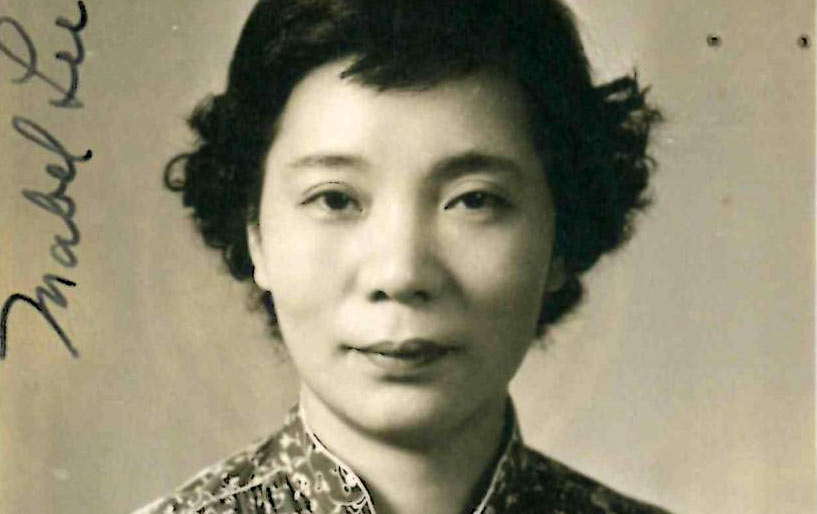
The 16-Year-Old Chinese Immigrant Who Helped Lead a 1912 US Suffrage March
Mabel Ping-Hua Lee fought for the rights of women on two sides of the world.
Courtesy of Michael Lee
In 1900, at a time when the Chinese Exclusion Act of 1882 banned most Chinese immigration and reflected a climate of deep anti-Asian prejudice, 9-year-old Mabel Ping-Hua Lee came to America from China on a scholarship to attend school. At 16, she would cement her place in women’s suffrage history, helping to lead a storied New York City march.
But while she fought for women’s voting rights, she herself would not be eligible to cast a ballot for decades after the 19th Amendment was ratified in 1920. That’s because the Exclusion Act prohibited Chinese immigrants from obtaining any rights of American citizenship.
Still, Lee continued to fight — not only for suffrage, but for education and equality — for women on both sides of the world, while working locally to raise up her own Chinatown community.
READ MORE: Before the Chinese Exclusion Act, This Anti-Immigrant Law Targeted Asian Women
Suffragists Tapped Into Chinese Politics

How did an immigrant teenager living in New York’s insular Chinatown attract the attention of voting rights activists? In 1911, when a revolution upended China’s imperial system and established the Republic of China, U.S. suffragists took note of news that women there, while long subjugated, had gained some voting rights. In the spring of 1912, they reached out to Chinese enclaves around the U.S., inviting women to white suffrage meetings to share tales of women’s role in the uprising. Mabel Lee, still in high school but already active politically, was among the invited speakers.
Lee and her family, who immigrated under a slim exception to the Exclusion Act, held prominent roles in New York City’s Chinese community. Her father served as a Baptist missionary pastor in Chinatown, and both parents worked for the church as teachers. They raised their daughter to be politically aware and modern, refusing to bind her feet as her mother’s had been — a stark reminder of how Chinese women had been traditionally held back for centuries. As a teen, Mabel worked in the community YWCA and helped raise money for Chinese famine victims.
At the suffrage meeting, 16-year-old Lee spoke about her beliefs of equal educational opportunities for Chinese children in New York City and the discrimination Chinese women faced in America.
Her presence impressed the suffragists, prompting them to invite Lee to help lead New York City’s upcoming 1912 suffrage parade.
The New-York Tribune, one of several newspapers that trumpeted her role in the upcoming parade, cited her “brilliant accomplishments” and credited her family: “Miss Lee inherits from her father a strong mind and an admiration for American institutions. This mind is, indeed, so strong that it compels her to look through what she considers the one defect in the institutions — namely, the limited franchise (suffrage).”
Lee Rode at the Head of the Suffrage March
On May 4 of that year, Lee was among several dozen women riding on horseback ahead of an estimated 10,000 protesters (including many sympathetic men). They marched up Fifth Avenue, starting in Greenwich Village and ending at Carnegie Hall.
The New York Times, in its extensive, multi-page coverage of the event, reported that the advance guard on horseback (Lee among them) wore black three-cornered hats and “Votes for Women” sashes. The Times noted that least one of the parade banners expressed suffragists’ support for their Chinese sisters in America, reading: “Women Vote in China, But Are Classed With Criminals and Paupers in New York.” And it made mention of Lee’s mother and other women from New York’s Chinatown who marched with the sign “Light from China.”
She Continued Speaking Out for Women’s Rights
After the parade, Lee attended Barnard College and went on to earn a Master’s degree from Columbia Teachers College. Later, at Columbia, she became the first Chinese American woman to earn a doctorate in economics.
Throughout, she continued fight for women’s voting rights—and more. In May 1914, at the age of 18, she published “The Meaning of Woman Suffrage” in the college’s The Chinese Student Monthly, where she wrote that “the fundamental principle of democracy is equality of opportunity,” including the right for women’s suffrage. In 1915, she presented a speech, “The Submerged Half,” that argued for gender equality in China.
“I plead for a wider sphere of usefulness for the long submerged women of China,” Lee said in the speech. “I ask for our girls the open door to the treasury of knowledge, the same opportunities for physical development as boys and the same rights of participation in all human activities of which they are individually capable.”
And in 1917, Lee led another suffrage parade, this time consisting of Chinese and Chinese Americans.
“She did all of this at a time where there was something called the Asiatic Barred Zone,” says Queens College President Frank Wu, who specializes in Asian American and Pacific Islander history. Given the limitations this “zone” put on Chinese immigrants in America, “Mabel’s accomplishments are remarkable, period.”
READ MORE: Why the 19th Amendment Did Not Grant All Women the Right to Vote
Lee Herself Wasn’t Eligible to Vote Until the 1940s
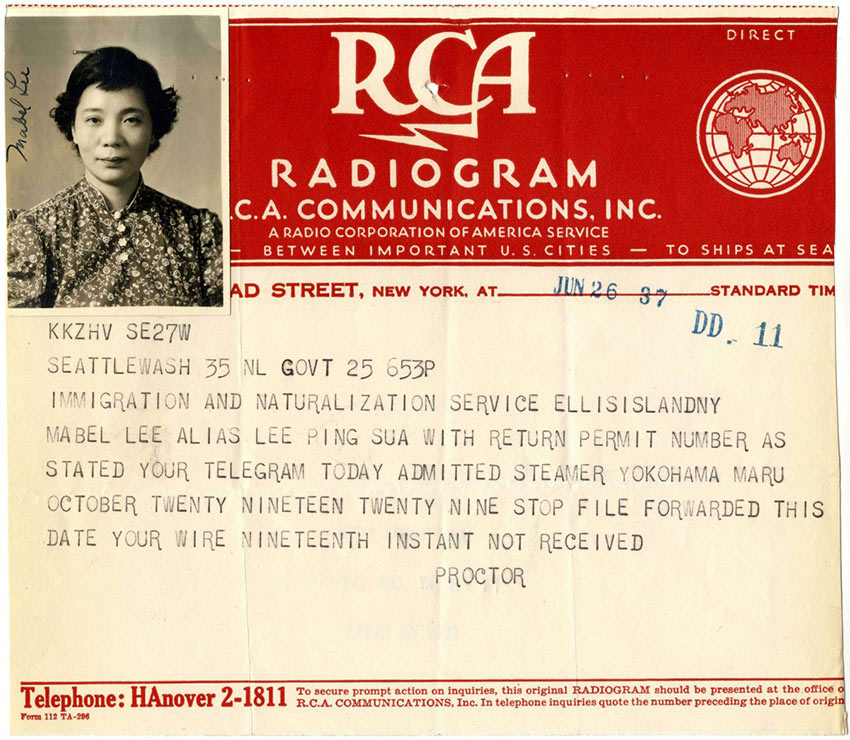
Despite Lee’s activism championing women’s suffrage, she wouldn’t be able to vote until long after the 19th Amendment passed — when the Chinese Exclusion Act was repealed in 1943.
Still, according to Laura Nechamkin, director of education at the Museum of Chinese in America in New York City, Lee did all of this because women’s suffrage in America embodied the egalitarian ideals she believed in. She also hoped it would give rights to — and help to lift up — a part of her own community: Chinese Americans born in the U.S. “While it was completely selfless for her to do this, knowing that [suffrage] wouldn’t apply to her for some time to come, it doesn’t mean that the hope for this equality of opportunity is not out there,” says Nechamkin.
Her goal was to eventually return to China to fight for equal educational opportunities with women there. But she never permanently returned. When her father died in 1924, she became the director of the First Chinese Baptist Church in New York City, shifting much of her focus to providing resources to her local Chinese community. There, she was known for founding the Chinese Christian Center which had a health clinic, kindergarten, vocational training and English classes.
Lee accomplished much in her life up until her death in 1966. “What’s most shocking is that it doesn’t seem like anyone knows if she ever did vote… once all the barriers were finally removed,” says Nechamkin.
Even so, she helped pave the way for others to do so, adding a valuable voice to the women’s suffrage movement, one that would continue until the Voting Rights Act in 1965.
Extreme Places: A Night in an Ice Hotel
Spending a night in ice and snow is possible in the far north of Europe. The “Icehotel” in Jukkasjärvi, Sweden, was built back in 1989, making it the first of its kind ― and therefore part of our “Extreme Places” series.
Courtesy Hendrik Welling, DW reporter
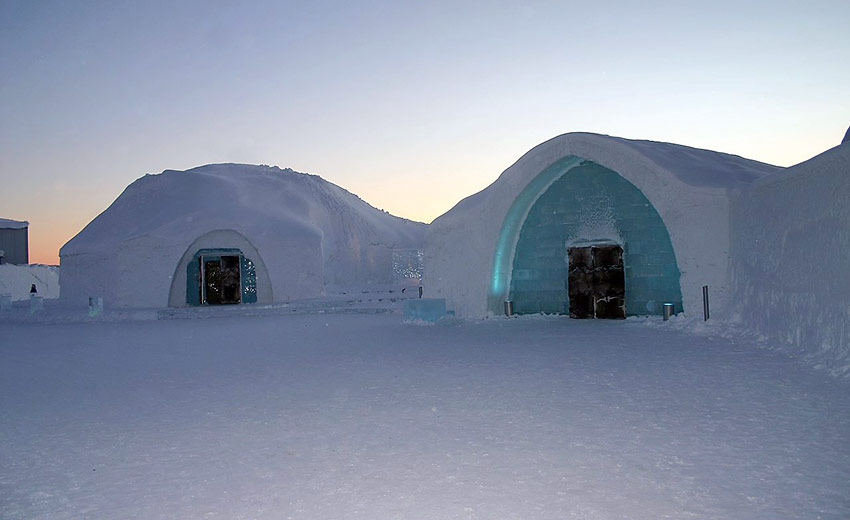
A visit to an ice hotel isn’t exactly the first choice if you prefer to spend your holidays under palm trees in warmer climes. But if you can manage to overcome your fear of freezing, you’ll be rewarded with a unique natural experience.
Visitors to this hotel spend the night amid ice and snow around 200 kilometers (about 125 miles) north of the Arctic Circle, in the Swedish locality of Jukkasjärvi.
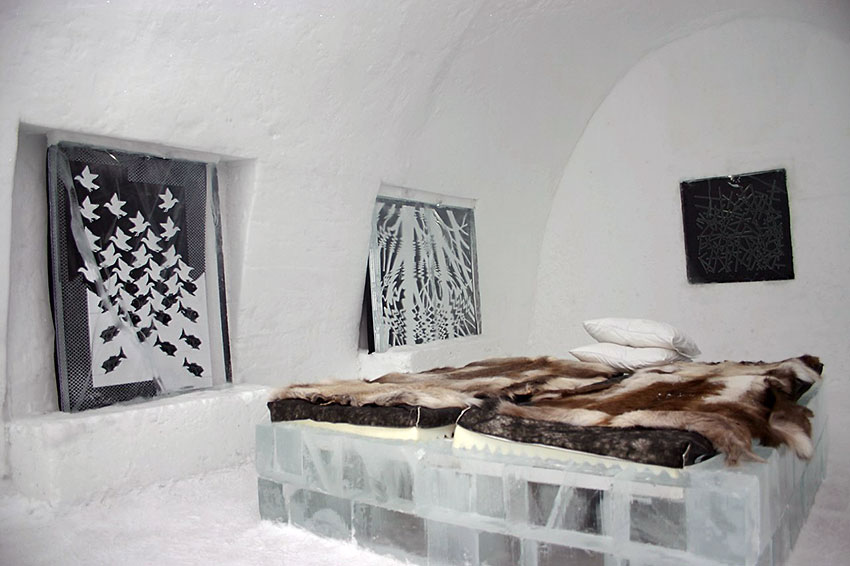
Ice-Cold Experience: A Night in the Icehotel
DW reporter Hendrik Welling found out what that feels like. For the “Europe to the Maxx” in DW’s magazine “Euromaxx,” he regularly explores places in Europe that hold a record all their own. He traveled to Europe’s oldest ice hotel in Sweden. Even the journey by snowmobile through the frozen landscape was a bit of an adventure. Find out how he experienced the night in sub-zero temperatures ― and whether he was lucky enough to see the famous northern lights ― in the video.
From Art Gallery to Hotel
Everything began in 1989, with an exhibition of ice art. A large igloo was created as an exhibition space for the cold creations. A short time later people wanted to spend the night in the icy atmosphere, and thus the idea of an ice hotel was born. The project grew bigger and bigger, but the artistic approach remained.
The Icehotel is today not only the oldest establishment of its kind, but also kind of a huge art gallery. Every room has its own motto. Artists from all around the world transform the frosty bed chambers into elaborately designed suites with ice sculptures and other creative details ― every winter anew.
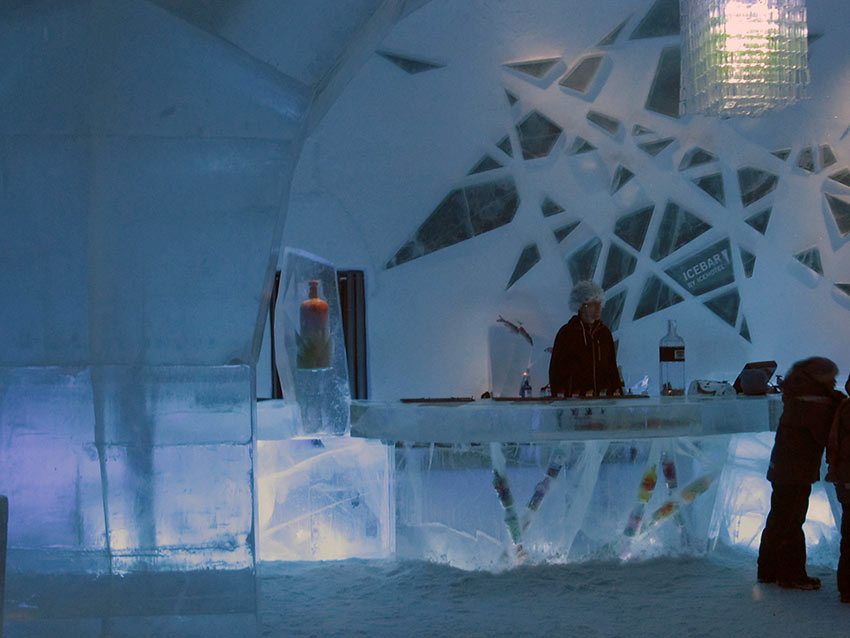
The work begins in October, when the temperatures in Jukkasjärvi drop ever lower. The “building material” for the unusual hotel comes from the frozen river Torne, with extremely heavy blocks of ice used in the construction. Mixed with snow, they become Icehotel’s walls, beds and sculptures.
A Whole World Made of Ice
Alongside the actual hotel rooms, a hotel lobby, a bar and a church are also made this way. Like in a classic igloo, the dome-shaped structures are self-supporting. The thick walls of ice and snow insulate the rooms. As a result, even if the temperatures outside sink to -30°C (-22°F), it stays at minus five inside – small mercies! In order for them to weather the night in this ice-cold setting in relative comfort, visitors are given especially warm sleeping bags. And for those who are still cold, there’s always the house recipe for warming you up: a hot glass of cranberry juice.
Address: Icehotel, Marknadsvägen 63, 98191 Jukkasjärvi, Sweden
Getting there: Train or plane to Kiruna, then to the hotel by bus, taxi, snowmobile or dogsled
Hours: December-April; an off shoot, Icehotel 365, is open all year round ― cooled by energy generated via solar panels in the roof
Special tip: Observe the Northern Lights near Jukkasjärvi on a dogsled tour
Global Rescue: Going into the Wilderness
Spring is here and people restless from the pandemic protocols will start hitting the trails, pitching camp site tents, and exploring the great outdoors.
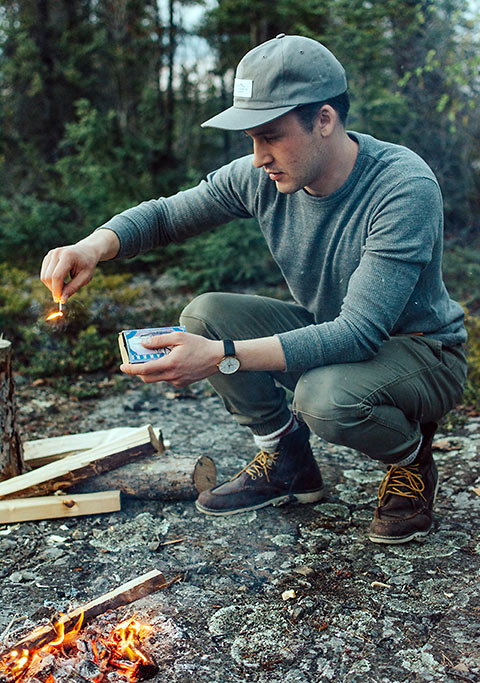
“Going into the wilderness means you are entering some level of a survival situation. There are many emergencies and contingencies in the backcountry that do not have a medical requirement. For these instances, you need survival equipment,” said Harding Bush, a former Navy SEAL and the senior survival instructor at the U.S. Navy Survival, Evasion, Resistance and Escape (SERE) Course in Rangeley, Maine.
What to Pack in a Survival Kit
Anytime you take yourself into the wilderness, you are entering some level of a survival situation.
There are many emergencies or contingencies in the backcountry that do not have a medical requirement. For these instances, you need survival equipment. Some of this survival equipment are things you use routinely throughout your time in the backcountry, and some are specific to an emergency.
The emergency use items should be in a “survival kit.” Backcountry enthusiasts must understand the survival or life support aspects of all their equipment, ensuring they are proficient at using the equipment when most needed.
When going into the backcountry, planning for survival is not that different than typical planning requirements. All your safety and survival needs fall into one or more of the following categories:
- Communications
- First aid
- Food and water
- Shelter
- Fire
- Navigation
These six requirements remain consistent; however, the importance of each changes with geographic location and the duration of your planned trip. If you are doing a multi-day winter hike over the Presidential range in New Hampshire’s White Mountains, shelter takes priority over water. Water would take precedence in an overland desert crossing.
A Survival Scenario
Your survival kit is for emergencies — unexpected occurrences where, for some reason, you find yourself overwhelmed and are facing a direr situation than planned.
Here’s an example. You decide to climb a local mountain with a friend. The nine-mile trail is relatively easy, you have both done it before, it is a warm late winter/early spring day, and the weather forecast remains good. About halfway through the hike, your friend sprains an ankle, and walking is too painful.
You planned well — you know your exact location and have the number for the ranger station, but your cell phone is disabled because it fell in the stream when you were refilling your water bottle. You ask your friend to use his cell phone and he says he left it in the car because he did not think there would be service, plus “you had yours.”
At this point, you assess the situation. It is getting dark, there are not many hikers on the trail, and staying put until daylight is likely your best option. It is not a good idea to leave your friend alone — if you go for help, you could become injured or lost.
You are near the top of the mountain in a lightly wooded area next to a stream. Your biggest problem when you think about survival priorities is you cannot communicate for help with your cell phone. You did let someone know where you were going and when you planned to return — and most importantly, what to do and who to contact if you did not check back in with them by a specific time.
Your friend wrapped his ankle with the ace wrap in his first aid kit and took a few aspirins. It is going to be a long, chilly night. Your mind begins to rush. You’ll need to stay warm, you did not plan to spend the night — how are you going to survive?
Now you are thinking about shelter. You do not have sleeping bags, you do not have a tent, but clothing falls into the shelter category. You both are wearing fleece tops, rain jackets and wool hats.
You consider building a fire for warmth, knowing that someone may see the fire and send help (fire falling into the communications category). Then you realize there are bouillon cubes in your survival kit and know fire also falls into food and water because now you can boil up a nice cup of soup in an aluminum tin cup.
With darkness approaching, your friend lying down with his leg elevated on a log. You put on your headlamp (with fresh batteries), which is always in your backpack. You head into the woods to collect some firewood. Small, dead branches (no thicker than a pencil) cut with the saw on your Swiss Army knife from standing dead trees make good kindling, and the larger branches make good fuel to sustain the fire.
When you return, your friend is shivering. The cold ground is drawing the heat from his body quickly.
The saw on the Swiss army knife now falls into the shelter category as well as the fire category. You use the saw to cut several pine boughs from the bottom of pine trees. When these pine boughs are placed between the ground and your friend, they will provide some insulation so all his heat will not be lost into the cold ground.
The space blanket from your friend’s survival kit wrapped around him will hold in body heat. You do not have a space blanket in your survival kit, but you have a warm down insulating jacket.
You start the fire using some of the small fire starters in your survival kit and some bark you peeled of a birch tree. Unfortunately, the butane lighter you brought was out of fuel. It had been in your pack so long it cracked, and the fuel was gone.
You attempted to use the fancy survival magnesium striker in the survival kit, but could not figure out. But the waterproof matches in the small waterproof container worked really. You are patient, letting the fire get hot and waiting for kindling to fully ignite and burn before adding the bigger, longer burning pieces of firewood. Successful fire starting in the wilderness requires planning and patience.
A few hours have passed. You made additional trips for wood and the fire is warm. You and your friend had the warm broth for dinner. You refilled your water bottles at the stream using your small water purifier and you both are hydrated. Your down jacket is on and, even though it is a clear night, you added the rain jacket over the down jacket as it holds in heat.
Before calling it a night, you boil one last cup of water, pour the boiling water into a Nalgene bottle, and put that bottle between your down jacket and fleece. You are now toasty warm and doze off safely, thinking of everything that went well, everything that could have gone better, and how you will be better prepared on your next trip.
You are awakened just before sunrise by the sound of voices over two-way radios; the rangers have found you. It was a combination of people seeing a fire where there usually wouldn’t be one and the person back home with your plan calling the ranger station and telling them you had not checked in with them after your hike.
As you can see from the example, a survival situation in the backcountry requires more than just a survival kit. Effective planning, common sense and experience contribute to a successful and safe wilderness adventure. It is not usually a single major mistake or event causing these life-threatening situations; it is typically a series of smaller misjudgments, mistakes or mishaps that, when combined, culminate in a catastrophe.
Survival Considerations
Here are some ideas to consider when building a survival kit.
Don’t Overdo It
If you need to take so much survival gear it overwhelms your pack, choose another activity; you are not going to enjoy yourself. More likely, you are not realistic about the risks and your capabilities. If you are not an experienced trapper, don’t plan on trapping and animal for food. (Do you even know how to skin and prepare a squirrel or chipmunk?) The same with fishing line hooks and lures. You are better off bringing bouillon cubes and energy bars in a survival kit.
If you have a sleeping bag, bivy bag, ground pad and tent, you don’t need a large tarp for survival. A space blanket will be sufficient. The larger, more durable, waterproof space blankets reflective on one side and bright on the other (signaling) are ideal for survival consideration in colder temps.
Protect Your Equipment
All electronics, phones, GPS and satellite messaging devices should be protected from the elements and potential impact. Waterproof containers or cases should be considered. Just because a manufacturer says an item is guaranteed to be waterproof does not mean it necessarily is — a guarantee means nothing out in the wilderness. Quality zip lock bags are practical waterproofing, especially if they are doubled up and you are not in a maritime environment. For a maritime environment, use dry bags or hard waterproof cases.
Understand that much of your equipment, depending on the environment, is life support equipment. This includes water bottles, an aluminum cup for boiling water, a sleeping bag and ground pad, and clothing items such as hats, mittens and even sunglasses.
Water bottles should be in a secured backpack pouch, not placed where it can fall out with you not knowing. Water purifying pumps are prone to breakage if they are not well protected. Chemical options, such as chlorine or iodine tablets, should be in the survival kit for this reason.
Know Your Gear
Be familiar with all your equipment and practice using it before leaving for the backcountry. If you have a spring-loaded ferro rod fire starter in your survival kit, make sure you know how it works and you have practiced with it at home. If you have iodine or chlorine tablets for purifying water in your survival kit, learn how to use them. If you plan on boiling water to purify it, you must have something to boil the water in. There are aluminum cups with collapsible handles that a Nalgene bottle fits into.
Electronics Will Fail
Have a back-up plan for anything electronic related. Even if you are navigating on your phone or GPS, you must also have — and know how to use — a map and compass. Phones lose service, GPSs lose connections in thick forests and steep terrain, batteries die and machines break.
Have extra batteries or charging capability for all electronic devices. A communications plan needs to include non-electronic back-up, such as leaving a trip plan with a responsible person. You should also bring non-electronic emergency signaling devices such as a whistle, strobe light, signal mirror or other ground-to-air signals, such as a bright colored space blanket, parka or sleeping bag.
Understand how to use your mobile or satellite phone. Make you have a written copy of all important numbers, laminate these numbers, and put them in your rainproof notebook. It’s handy to have a small notebook to write down instructions from a rescue service or write down critical information, such as your geographic coordinates, before making an emergency call. Bring a few pencils, not pens because pens break and ink freezes.
Pack Items With Purpose
Why would you ever carry a knife with a single blade when you can bring a knife with multiple blades and multiple uses? Swiss Army Knives or multi-tools, for example, are a much better option. These multi-feature knives have knife blades for cutting cord to make a shelter, a saw to cut kindling wood, can openers, tweezers and scissors (which help with first aid), screwdrivers and pliers (to repair or maintain equipment).
The uses for zip ties, paracord and duct tape are endless. With these items, you can fix nearly anything long enough to get out of the field safely. Wrap 20 feet of duct tape around a Nalgene bottle, dog-ear the end tape so you can peel it off without removing your gloves. It is even better if the tape is bright orange — you now have a water bottle that is part water bottle, part signaling device, repair kit and first-aid kit.
Be Prepared for the Night
Always carry a quality headlamp and extra batteries. Headlamps are critical because they leave your hands free to cut kindling wood, conduct first aid and boil water in the dark.
There are numerous small stoves, either liquid fuel or gas canister, you should always carry while in the backcountry. However, these stoves are useless if you don’t have a metal or aluminum cup.
Always have the ability to make fire. This includes a windproof lighter in your pocket, a mechanical fire starting device in your pack, and waterproof matches in a waterproof container in your survival kit. Small tea candles are a good idea; they can provide light and they will save many matches.
Something warm to eat or drink is essential in colder environments; having a stove, fuel and small pot to boil water in is critical. A warm meal or drink can make a cold night seem a lot shorter.
Where Do I Carry My Survival Kit?
It is important to understand that much of your gear can be considered “survival gear” once in an emergency situation.
Do not split up survival gear. You may find yourself alone. Everyone should have their own first aid kit and critical survival gear. Everyone should have a portable stove, fuel and pot in colder environments for the same reason.
There are survival items you will use throughout your time in the backcountry, like your water bottle and clothing.
Other items take on more of a life support role, depending on the weather or environment. Contingency items can be safely tucked away, ready for use when necessary. Here’s a few survival kit items that can be packed away in a small pelican case for contingency use:
- Waterproof matches
- A small compass
- A small sewing kit
- 50 feet of paracord
- 20 feet of duct tape
- Extra batteries for everything
- Water purification tablets
- Small candles
- Waterproof matches
- Space blanket
- Signal mirror, whistle or emergency flares
- Bouillon cubes or energy bars
- Some cash
Items specific to survival can be stored in a small waterproof container.
Learn and Practice Survival Skills
While effective learning takes place after making mistakes in the backcountry, it is not a good idea to head into the backcountry with just your survival gear with the intent of learning to use it. Practice survival skills in a safe and supervised environment and be thoroughly comfortable using them before your trip.
Ideas From the Experts
Everyone has different experiences with survival. Ask people familiar with backcountry expeditions their thoughts and ideas for survival kit necessities and you’ll get various suggestions.
Jeff Weinstein, medical operations supervisor at Global Rescue, recommends additional items depending on kit size, means of travel, trip location, wants and needs. He might bring super glue, hooks and fishing line, tea light candles, and one meal of freeze-dried food.
“I add half a dozen zip ties, a small roll of duct tape, and a couple of lighters as well as a magnesium fire starter. I always carry a headlamp with me as well,” said Pat Pendergast, director of international travel at The Fly Shop, a leading fly fishing outfitter, travel agent and retail store.
Ian Taylor of Ian Taylor Trekking has run quality treks, climbs and expeditions around the world “Your down jacket may be one of the most important purchases you will make. Having the right warm, insulating layer can make or break your enjoyment level on a trekking or climbing trip around the world,” he said. “Remember there is no ‘one size fits all’ when it comes to gear. You will need different layers and down jackets, depending on the month you decide to travel and the adventure you have chosen.”
No matter where she travels, Amy Ray, president of The Sisterhood of the Outdoors, a company dedicated to creating opportunities for women to hunt, fish and learn to shoot, always carries a rescue blanket, a whistle, duct tape, a lighter and cotton balls.
“I’m in the habit of carrying these items every day,” she said.




